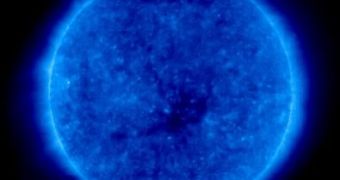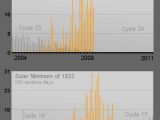The Sun continues its relatively long period of inactivity, although while some claim that this lengthy phase without sunspots is somehow unusual, NASA researchers argue that the sun is in fact behaving normally and this period of calm is anything but long. "The sun is now near the low point of its 11-year activity cycle. We call this 'Solar Minimum.' It is the period of quiet that separates one Solar Max from another," said NASA solar physicist David Hathaway.
The Solar Maximum is expressed by the Sun through an increase in the number and size of sunspots, which in turn trigger solar flares whose effects are visible on Earth through the occurrence of Auroras in the low latitudes of the globe or through disruptions in the functioning of artificial satellites and electronic equipment working in the radio wavelengths of the electromagnetic spectrum.
By contrast, during Solar Minimums little or no sunspots are present on the surface of the Sun. These periods of low solar activity, such as the current one, are in fact normal phases of the solar cycle, although some claim that the current solar minimum has somehow extended for too long, entering its third year.
"It does seem like it's taking a long time, but I think we're just forgetting how long a solar minimum can last," said Hathaway. Historical records show that the 20th century saw periods of solar minimum nearly twice as long as the current one and nothing spectacular happened back then.
"The average period of a solar cycle is 131 months with a standard deviation of 14 months. Decaying solar cycle 23 (the one we are experiencing now) has so far lasted 142 months--well within the first standard deviation and thus not at all abnormal. The last available 13-month smoothed sunspot number was 5.70. This is bigger than 12 of the last 23 solar minimum values. Thus the current minimum is not abnormally low or long," says Hathaway.
A truly long period of solar inactivity was recorded between 1645 and 1715, when the Sun rarely presented any sunspots at all and in fact even determined a small Ice Age on Earth, while some researchers say that the slight drop in temperature during the 17th century was largely affected by an increase in the volcanic activity on our planet.
Since then however, the Sun has been carrying out a cycle with a period of roughly 11 years, albeit since they don't know much about what determined the 70 year period of inactivity of the Sun, researchers are continuously looking for indications to whether or not it may occur again sometime in the future.
"We have already observed a few sunspots from the next solar cycle. This suggests the solar cycle is progressing normally," said Hathaway, again pointing that there is still no evidence that another Maunder Minimum (1645-1715) is about to occur.

 14 DAY TRIAL //
14 DAY TRIAL // 
